Related Research Articles

Snowdonia, or Eryri, is a mountainous region and national park in North Wales. It contains all 15 mountains in Wales over 3000 feet high, including the country's highest, Snowdon, which is 1,085 metres (3,560 ft) tall. These peaks are all part of the Snowdon, Glyderau, and Carneddau ranges in the north of the region. The shorter Moelwynion and Moel Hebog ranges lie immediately to the south.

Gwynedd is a county in the north-west of Wales. It borders Anglesey across the Menai Strait to the north, Conwy, Denbighshire, and Powys to the east, Ceredigion over the Dyfi estuary to the south, and the Irish Sea to the west. The city of Bangor is the largest settlement, and the administrative centre is Caernarfon. The preserved county of Gwynedd, which is used for ceremonial purposes, includes the Isle of Anglesey.

Snowdon, or Yr Wyddfa, is a mountain in Snowdonia, a region of North Wales. It has an elevation of 1,085 metres (3,560 ft) above sea level, which makes it both the highest mountain in Wales and the highest in the British Isles south of the Scottish Highlands. Snowdon is designated a national nature reserve for its rare flora and fauna, and is located within Snowdonia National Park.

Bala Lake, or Llyn Tegid, is a large freshwater glacial lake in Gwynedd, Wales. The River Dee, which has its source on the slopes of Dduallt in the mountains of Snowdonia, feeds the 3.7 miles (6.0 km) long by 0.5 miles (0.8 km) wide lake. It was the largest natural body of water in Wales even before its level was raised by Thomas Telford to provide water for the Ellesmere Canal.
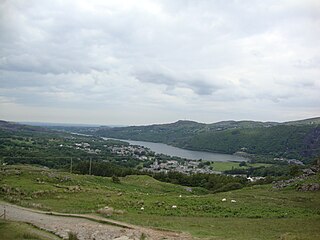
Llanberis is a village, community and electoral ward in Gwynedd, northwest Wales, on the southern bank of the lake Llyn Padarn and at the foot of Snowdon, the highest mountain in Wales. It is a centre for outdoor activities in Snowdonia, including walking, mountaineering, climbing, mountain biking and pony trekking, as well as water sports such as scuba diving. The community includes Nant Peris.
The National Three Peaks Challenge is an event in which participants attempt to climb the highest mountains of England, Scotland and Wales within 24 hours. It is frequently used to raise money for charitable organisations. Walkers climb each peak in turn, and are driven from the foot of one mountain to the next. The three peaks are:

Glaslyn is a lake in the Snowdonia National Park in Gwynedd, north-west Wales.

Glyder Fawr is a mountain in Snowdonia, Wales, the highest peak in the Glyderau range at just over 1,000 metres. It is the fifth-highest mountain in Wales and has several walking and scrambling routes leading to its summit. According to Sir Ifor Williams, the word "Glyder" derives from the Welsh word "Gludair", meaning a heap of stones.

Carnedd Llewelyn, also spelled Carnedd Llywelyn, is a mountain massif in the Carneddau range in Snowdonia, north-west Wales. It is the highest point of the Carneddau at 1,064m (3,491ft) and the second highest peak by relative height in Wales, 49th in the British Isles and lies on the border between Gwynedd and Conwy.

Cadair Idris or Cader Idris is a mountain in the Meirionnydd area of Gwynedd, Wales. It lies at the southern end of the Snowdonia National Park near the town of Dolgellau. The peak, which is one of the most popular in Wales for walkers and hikers, is composed largely of Ordovician igneous rocks, with classic glacial erosion features such as cwms, moraines, striated rocks, and roches moutonnées.
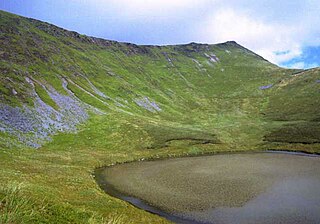
Cadair Berwyn, Cader Berwyn or Craig Uchaf is a mountain summit in north-east Wales with a height of 832 metres (2,730 ft) above sea level. It is the highest point in the Berwyn range, the highest in North East Wales and the highest significant summit in Wales outside the National Parks. Cadair Berwyn and Foel Cedig to the west are the two Marilyns that form the Berwyn range. The undulating plateau of the range also includes a large number of other summits above 2,000 feet (610 m), including satellite summits of Cadair Berwyn and many which are classed as Nuttalls.
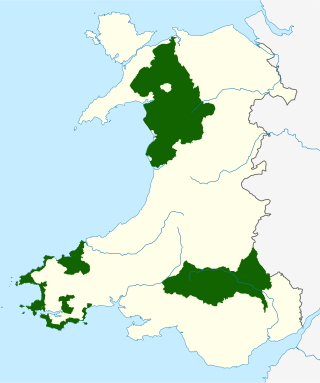
The national parks of Wales are managed areas of outstanding landscape in Wales, United Kingdom where some forms of development are restricted to preserve the landscape and natural environment. Together, they cover 20% of the land surface of Wales and have a resident population of over 80,000 people. Each National Park Authority is a free-standing body within the local government framework.
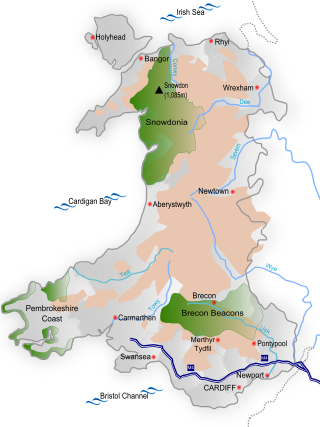
Wales is a country that is part of the United Kingdom and whose physical geography is characterised by a varied coastline and a largely upland interior. It is bordered by England to its east, the Irish Sea to its north and west, and the Bristol Channel to its south. It has a total area of 2,064,100 hectares and is about 170 mi (274 km) from north to south and at least 60 mi (97 km) wide. It comprises 8.35 percent of the land of the United Kingdom. It has a number of offshore islands, by far the largest of which is Anglesey. The mainland coastline, including Anglesey, is about 1,680 mi (2,704 km) in length. As of 2014, Wales had a population of about 3,092,000; Cardiff is the capital and largest city and is situated in the urbanised area of South East Wales.

Arenig Fawr is a mountain in Snowdonia, North Wales, close to Llyn Celyn reservoir, alongside the A4212 between Trawsfynydd and Bala.

The Summit railway station is the southern, upper terminus of the Snowdon Mountain Railway, located within yards of the summit of Snowdon. In 2009 a new station building was opened, which was named Hafod Eryri.
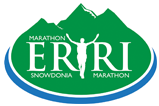
The Snowdonia Marathon, known as Marathon Eryri from 2023, is a marathon in Snowdonia (Eryri), North Wales. It was established in 1982 as an alternative to city and town races. The route makes a circumnavigation of the Snowdon massif, starting and finishing at Llanberis. It is held annually in October.

Llanegryn is a village and a community in Gwynedd, north-west Wales. It was formerly part of the historic county of Merionethshire. It is located within Snowdonia National Park south of the Snowdonia (Eryri) mountain range. Travelling by road, it is around 4 miles (6 km) north-east of Tywyn and 17 miles (27 km) south-west of Dolgellau. The nearest railway stations are at Tonfanau and Llwyngwril, both less than 3 miles (5 km) away.

Llyn Bochlwyd is a lake in Snowdonia, Wales, in Conwy County Borough. It lies in Cwm Bochlwyd, near Llyn Ogwen in the Glyderau mountain range.

The geology of Snowdonia National Park in North Wales is dominated by sedimentary and volcanic rocks from the Cambrian and Ordovician periods with intrusions of Ordovician and Silurian age. There are Silurian and Cenozoic sedimentary rocks on the park's margins. The succession was intensely faulted and folded during the Caledonian Orogeny. The region was uplifted as the North Atlantic Ocean opened during the Cenozoic. The current mountainous landscape arises from repeated glaciations during the Quaternary period.
References
- ↑ "Place Names". Snowdonia National Park. Retrieved 24 November 2023.
- 1 2 Jones, Rhys (2 February 2023). "Welsh place names are being erased – and so are the stories they tell". The Conversation. Retrieved 24 November 2023.
- ↑ "Outrage as caravan park replaces 100-year-old Welsh name with English alternative". ITV News . 29 April 2022.
- ↑ Renwick, Will (19 April 2023). "Welsh places often get renamed - but usually into English". TGO Magazine. Retrieved 24 November 2023.
- 1 2 3 4 5 "Snowdon: Park to use mountain's Welsh name Yr Wyddfa". BBC News. 16 November 2022. Retrieved 24 November 2023.
- ↑ G, Ioan (16 November 2022). "Paper on Place Names Principles approved in order to safeguard and celebrate Welsh place names within the National Park". Snowdonia National Park. Retrieved 24 November 2023.
- ↑ "Eryri National park lake names to only be referred to in Welsh". ITV News . 16 November 2023.
- ↑ GwenAeron (15 November 2023). "The National Park Authority, The School of Welsh at Cardiff University and the Welsh Language Commissioner work in collaboration to standardise a list of Eryri's lake names". Snowdonia National Park. Retrieved 22 November 2023.
- 1 2 3 "Wales' largest national park to only use Welsh names for lakes and waterfalls". The Independent. 19 November 2023. Retrieved 24 November 2023.
- 1 2 3 "Snowdonia: Eryri National Park to use Welsh lake names only". BBC News. 15 November 2023. Retrieved 24 November 2023.
- ↑ NationCymru (4 August 2020). "It's Llyn Bochlwyd, not Lake Australia: Why we should protect our Welsh place names". Nation.Cymru. Retrieved 24 November 2023.
- ↑ "Yr Wyddfa: National park to continue using Welsh name for Snowdon". www.bbc.com. Retrieved 11 November 2024.
- ↑ Williams, Sally (23 September 2009). "Honour bestowed on Wales 'lost Princess'". Wales Online. Retrieved 24 November 2023.
- ↑ Jones-Williams, Eryl (13 April 2016). "Cadair or Cader Idris? Row breaks out over Snowdonia mountain's spelling". North Wales Live. Retrieved 24 November 2023.
- ↑ "Row over spelling of Cader Idris mountain settled". BBC News. 8 June 2016. Retrieved 24 November 2023.
- ↑ "Cadair Idris sign campaign to name mountain Cader Idris". BBC News. 13 April 2016. Retrieved 24 November 2023.
- ↑ "Mount Snowdon to be known by Welsh name 'Yr Wyddfa' rather than English after National Park vote". ITV News . 17 November 2022.
- ↑ "Welsh Place Names". www.welshlanguagecommissioner.wales. Retrieved 18 November 2023.
- ↑ "Snowdon and Snowdonia to be referred to by Welsh names, authority decides". Cambrian News. 17 November 2022. Retrieved 24 November 2023.
- ↑ "Snowdonia Marathon ditches English name in favour of Marathon Eryri". Sky News. Retrieved 24 November 2023.
- ↑ Price, Stephen (20 November 2023). "Historic Welsh lake names safeguarded by National Park Authority". Nation.Cymru. Retrieved 22 November 2023.
- ↑ "NOTICE OF MEETING" (PDF). Snowdonia National Park Authority. 15 November 2023.
- ↑ "Notice of Meeting" (PDF). Snowdonia National Park Authority. 13 October 2021.